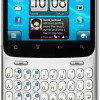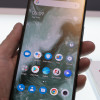Review: HTC Status
Screen
The Status's screen measures 2.6 inches across the diagonal and offers 320 x 480 pixels. Given the small space, the pixel density is fine. Everything on the Status's display looks sharp and is free of jagged edges. The brightness is also good, and it has a rich, warm look to it. As with many phones, it isn't very readable when outdoors. In my opinion, this display is a bit too small for a touch phone. Even 0.2 inches more would have been a big help in making the Status easier to interact with.
Signal
The Status performed excellently at connecting to AT&T's network. Most of the time I spent testing it, the device showed three or four bars of service. In points around New York City and northern New Jersey, it never lost AT&T's network entirely, and I only saw it drop from 3G down to EDGE once — when I was in a basement. The Status passed the NJ vault test (the local supermarket) and it connected all calls on the first dial. During my test period, the Status did not drop any calls, but it missed several that went straight to voicemail. Data sessions were consistently quick, even when the Status dropped to EDGE.
Sound
Sadly, call quality was sub-par. Most calls I made during my review period were static-ridden, with lots of background hiss. The volume was also inconsistent and calls cut in and out entirely from time to time, forcing me to ask people to repeat themselves. Thankfully, the earpiece could be set quite loud. This helped in instances when there was a lot of background noise, though it didn't make calls any clearer. The speakerphone was also good and loud, but the lousy call quality made it an unpleasant feature to use. Ringers and alert tones were good, and the vibrate alert was also solid.
Battery
HTC made have sacrificed screen size on the Status, but the benefit is outstanding battery life. From a full charge, the Status had barely sipped any of its power source 24 hours later. Even with social networks and email syncing constantly, the Status's battery life barely budged during the first day I used it. The Status also has a more power-efficient 800MHz processor, which is less needy than some of the dual-core 1GHz+ processors on HTC's top-of-the-line devices.


 AT&T Updates Its Facebook Status to Intro HTC Status
AT&T Updates Its Facebook Status to Intro HTC Status
 iPhone 14 Plus Offers a Big Screen For Less
iPhone 14 Plus Offers a Big Screen For Less
 TCL's Newest Concept Phone has a Matte Screen
TCL's Newest Concept Phone has a Matte Screen
 Qualcomm Taps Iridium for Satellite Connectivity
Qualcomm Taps Iridium for Satellite Connectivity
 HTC Status
HTC Status



